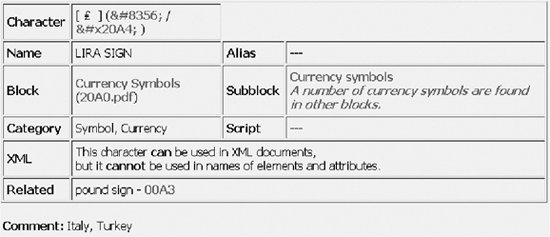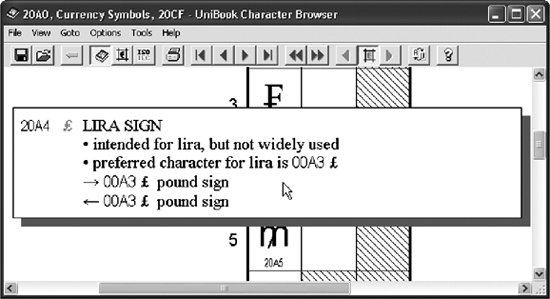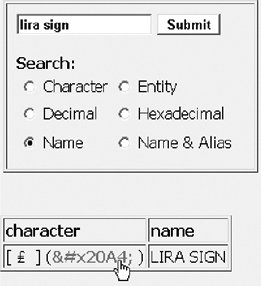Section 4.5. Guide to the Unicode Standard
4.5. Guide to the Unicode StandardThe newest version of the Unicode standard itself should be your ultimate reference in matters of Unicode. It is, however, very large and partly very technical and hard to read, though many parts are enjoyable and smoothly written. Perhaps most frustratingly, it is often difficult to find the place or places where some topic is covered; the information might be scattered to different sections of the standard. To help you to find the relevant information and to make use of it, here is a brief guide to the standard. 4.5.1. Accessing the Unicode VersionsThe Unicode standard is available online (mostly in PDF format), but not necessarily as a simple consolidated version. You may need to combine information from a major base version with later modifications issued as minor versions. At the time of this writing, the current version is 4.1.0, and its content is defined cumulatively by the following documents:
The Unicode database reflects the newest version, but the prose text and code charts may need to be read along with the update documents. A previous version of the standard, Unicode 3.0, is available online, too, and it might be interesting for comparison: http://www.unicode.org/unicode/uni2book/u2.html. There are also many old database files available via http://www.unicode.org/versions/. 4.5.2. What Material Constitutes the Unicode Standard?The Unicode standard is available as a book, though there can be a delay between issuing the standard and printing it. The online version contains PDF documents that correspond to the chapters of the book. But these alone are not self-contained presentations of the standard. There are several points to note. As mentioned earlier in the chapter, there can be incremental updates (minor versions):
4.5.3. Viewing the Standard OnlineAs mentioned earlier in the chapter, the online standard is mostly in PDF format. Thus, you need some software that can display PDF files, such as Adobe Reader. The online version cannot be printed using normal methods, so you may still have a reason to buy the printed standard. Copying of texts is possible: using Adobe Reader's text select tools, you can copy text onto the Windows clipboard. The main table of contents of the online version consists of the following parts:
4.5.4. The Chapters of the StandardThe breakdown of chapters is as follows:
Thus, Chapters 1 through 5 form the general part. Their essential content is covered in this book. The relevance of the other parts depends on what kinds of characters you work with. 4.5.5. How Do I Find All the Information About a Character?If you are looking for the most adequate Unicode character for some particular use, there is no simple answer. You might browse through the chart for the block where you expect the character to appear; for example, a mathematical symbol is probably in the Mathematical Symbols block. You can also use more systematic search methods. A few alternatives are described in the following sections. 4.5.5.1. The Zvon databaseIf your clue to the character is its name, or its Unicode number, you could use the online Zvon character database: http://www.zvon.org/other/charSearch/PHP/search.php. The database, although not authoritative, is based on information at the Unicode site. Beware that the name you have in your mind might not be the one under which the character is known in Unicodethe name might have been assigned to a different character there. The information in the Zvon database (of which an example is shown in Figure 4-3) is the same as in the Unicode code charts, including the annotations (called "Comment" in Figure 4-3. Information on a character in the Zvon database Zvon), and some additional derived information such as the XML character reference. The information does not include the notes made in the prose text of the standard. 4.5.5.2. Using UnibookUnibook is software for offline browsing of information about characters, using a graphic user interface, in a Windows environment. It can be downloaded for free from http://www.unicode.org/unibook/, and it has detailed instructions for installation and use. It has no technical support, though. Figure 4-4 is a snapshot of using Unibook: the user has searched for "lira sign" (using Ctrl-F to invoke a Find dialog) and has got the character highlighted in its position in a code chart. Clicking on the character causes information to be displayed in a pop-up window, as shown in Figure 4-5. 4.5.5.3. Using the Unicode standardAssuming that you know the code number of a character, at least as a tentative answer to the question "Which character should I use?", you can consult the following to see what the Unicode standard says about it:
Let us take a simple example: suppose we need all the information on the character U+2206. Since it falls into the range U+2200..U+22FF, we find it in the Mathematical Figure 4-4. Using Unibook, the Unicode character browser Operators block. This suggests that it is a mathematical symbol in some sense. The formal confirmation for this is that the Unicodedata.txt file in the character database contains the following entry for it: 2206;INCREMENT;Sm;0;ON;;;;;N;;;;; The file consists of lines, each of which gives information about a character, with information fields separated by semicolons. The fields are summarized in Table 4-5 and described at http://www.unicode.org/Public/UNIDATA/UCD.html in more detail. (See also Chapter 5 for a description of the general format of Unicode database fields.) Thus, the example tells that character U+2206:
Figure 4-5. Viewing character information in Unibook
Figure 4-6. Description of character U+2206 in a code chart
We find additional information on our sample character in the code chart for the Mathematical Operators block, as shown in the extract in Figure 4-6. The description characterizes some uses of the character by listing "Laplace operator" and "forward difference" as synonyms for it (in some usage). Obviously, the primary name suggests the use as an increment symbol in some sense. Note that this does not constitute an exclusive list of uses for the character by any means, or that it would be obligatory to use this character for those purposes even when it is available in the repertoire. The actual usage is a decision made by mathematicians. The description also clarifies that this is not the same character as Greek letter capital delta or a white up-pointing triangle (in the Geometric Shapes block). Note that an arrow means in principle just "cross reference," but quite often its specific purpose is to make it explicit that two characters are not equal, although they may have identical or similar glyphs. Then let us check what the corresponding general description in Chapter 12 says. The relevant part in the standard, section 14.4, contains a clarifying note. It says that the INCREMENT character is one of the mathematical operators derived from Greek characters that "have been given separate encodings because they are used differently from the corresponding letters." It adds: "These operators may occasionally occur in context with Greek-letter variables." (In contrast, Unicode 3.0 said that these characters "have been given separate encodings to match usage in existing standards.") In practice, there are borderline cases: when a character with the shape of a capital delta occurs in printed form only, or in an encoding that lacks a code corresponding to U+2206, it can be difficult to say whether it should be interpreted as the Greek letter (U+0394) or as U+2206. For example, what about the delta amplitude function or the symbol for the area of a triangle? There are also dozens of other properties defined for characters than those defined in the Unicodedata.txt file, as explained in Chapter 5. Although not all properties are practically relevant for all characters, many of them form part of the meaning of a character in a broad sense. They affect behavior like line breaking and writing direction. For U+2206, there are really no surprises in the properties. For example, in line breaking, it behaves the same way as letters, which should be suitable. On the other hand, for the en dash "" U+2013, for example, the Unicode line breaking rules allow a break after it (e.g., an expression like "58" could be broken as "5" on one line and "8" on the next). In borderline cases at least, such things might matter in the choice of character. Thus, the identification of a symbol as a particular Unicode character is not really an exact science. There are matters of interpretation, and there is no comprehensive index to all information on a character in the standard. 4.5.6. Additional Reference MaterialThe Unicode standard and its annexes is partly rather large and complex, and it is not always suitable for quick checks or efficient searches. You may therefore wish to consult other references as well, even though they are not authoritative. To a large extent, other references have been constructed automatically from material issued by the Unicode Consortium, but this does not guarantee that they are error-free; programs have bugs. Some practical references were listed in Chapter 1. The following online material is more technical or more specialized:
|
- Chapter III Two Models of Online Patronage: Why Do Consumers Shop on the Internet?
- Chapter VIII Personalization Systems and Their Deployment as Web Site Interface Design Decisions
- Chapter XIII Shopping Agent Web Sites: A Comparative Shopping Environment
- Chapter XIV Product Catalog and Shopping Cart Effective Design
- Chapter XVIII Web Systems Design, Litigation, and Online Consumer Behavior

